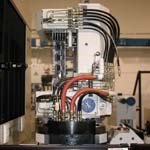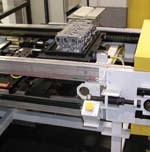An Intelligent Fixturing System
Have you ever wished for a workholding system that could (1) pick any of a family of parts from an assembly line, (2) identify it, (3) automatically fixture it, and (4) present it precisely oriented to a machine tool for machining or assembly?
Have you ever wished for a workholding system that could (1) pick any of a family of parts from an assembly line, (2) identify it, (3) automatically fixture it, and (4) present it precisely oriented to a machine tool for machining or assembly? If so, you may want to check out the Intelligent Fixturing System (IFS), which was introduced by Lamb Technicon (Warren, Michigan) at IMTS 2002.
The main elements of the IFS include a vision system, a flexible (universal) clamping system, a part location system, and a micropositioner that positions the fixture so that the workpiece is precisely aligned with the machine tool's axes. The process begins when a part from a family of parts is loaded—in any orientation—on a pallet or conveyor and moves to a vision station. The vision station identifies the part and communicates part details to the appropriate downstream stations that will be required to process it.
A robot removes the part from the vision station and inserts it in a flexible workholding fixture called the Flexible Clamping System. The C-shaped fixture is more familiarly referred to as a bed of nails, for the hefty (about ½-inch-diameter), evenly spaced pins that extend from its top and bottom to secure the part (photo). The pins automatically conform to the size and shape of the part and will secure any part that can fit within the fixture's envelope. No effort is made to precisely locate the part in the fixture; in fact, during the demonstration on the system at the show, the part was deliberately inserted askew.
After the part is secured, the entire fixture is transported to a CMM that locates the spatial position of the part. Although the position of the part in the fixture is fixed, the yaw and pitch of the fixture itself are adjustable. Accordingly, the part location data is communicated to a device called a Part Micropositioner, which adjusts the fixture to bring the part into the desired position. The Part Micropositioner corrects misalignments to an accuracy of 2 arc seconds (1/1,800 of a degree) before the part is machined.
Finally, the adjusted fixture is transferred via conveyor to a machining and/or assembly cell. One IFS can service multiple cells. The system can easily be reconfigured to accommodate parts of different sizes and shapes.
Automotive experts consider the dedicated fixturing used in most high volume machining operations to be the main barrier to the implementation of truly flexible machining systems for automotive parts production. The IFS eliminates the need for mechanical locators and employs a flexible clamping system that can hold a family of related parts, thus permitting high flexibility.
It is estimated that the IFS may result in a savings of $30 to $50 per vehicle (depending on powertrain option), resulting in $450- to $750-million in annual savings for automotive manufacturers. The figures are based on an annual domestic production of 15 million vehicles (cars and trucks).
Related Content
-
Medical Shop Performs Lights-Out Production in Five-Axes
Moving to five-axis machining enabled this shop to dramatically reduce setup time and increase lights-out capacity, but success relied on the right combination of workholding and automation.
-
Moving To Magnets Doubles Productivity
Moving from hydraulic to magnetic fixtures enabled this shop to reduce setup time, improve rigidity and eliminate manual operations. As a result, productivity doubled.
-
Lean Approach to Automated Machine Tending Delivers Quicker Paths to Success
Almost any shop can automate at least some of its production, even in low-volume, high-mix applications. The key to getting started is finding the simplest solutions that fit your requirements. It helps to work with an automation partner that understands your needs.



















